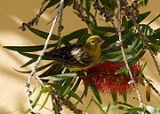
Canary
Overview
The Atlantic Canary also called the Island Canary, Canary or Common Canary, is a small passerine
bird
belonging to the genus
Serinus
in the finch
family, Fringillidae. It is native to the Canary Islands
, the Azores
, and Madeira
. Wild birds are mostly yellow-green, with brownish streaking on the back. The species is common in captivity and a number of colour varieties have been bred.
This bird is the natural symbol of the Canary Islands, together with the Canary Island Date Palm
.
The wild Atlantic Canary is approximately 12.5 cm long, with a wingspan of 20–23 cm and a weight of 15–20 g.
Passerine
A passerine is a bird of the order Passeriformes, which includes more than half of all bird species. Sometimes known as perching birds or, less accurately, as songbirds, the passerines form one of the most diverse terrestrial vertebrate orders: with over 5,000 identified species, it has roughly...
bird
Bird
Birds are feathered, winged, bipedal, endothermic , egg-laying, vertebrate animals. Around 10,000 living species and 188 families makes them the most speciose class of tetrapod vertebrates. They inhabit ecosystems across the globe, from the Arctic to the Antarctic. Extant birds range in size from...
belonging to the genus
Genus
In biology, a genus is a low-level taxonomic rank used in the biological classification of living and fossil organisms, which is an example of definition by genus and differentia...
Serinus
Serinus
The genus Serinus is a large genus of birds in the finch family Fringillidae found mostly in the Afrotropical region with some outlying species in Europe and Asia. The genus contains several species groups including canaries, seedeaters and the African siskins...
in the finch
Finch
The true finches are passerine birds in the family Fringillidae. They are predominantly seed-eating songbirds. Most are native to the Northern Hemisphere, but one subfamily is endemic to the Neotropics, one to the Hawaiian Islands, and one subfamily – monotypic at genus level – is found...
family, Fringillidae. It is native to the Canary Islands
Canary Islands
The Canary Islands , also known as the Canaries , is a Spanish archipelago located just off the northwest coast of mainland Africa, 100 km west of the border between Morocco and the Western Sahara. The Canaries are a Spanish autonomous community and an outermost region of the European Union...
, the Azores
Azores
The Archipelago of the Azores is composed of nine volcanic islands situated in the middle of the North Atlantic Ocean, and is located about west from Lisbon and about east from the east coast of North America. The islands, and their economic exclusion zone, form the Autonomous Region of the...
, and Madeira
Madeira
Madeira is a Portuguese archipelago that lies between and , just under 400 km north of Tenerife, Canary Islands, in the north Atlantic Ocean and an outermost region of the European Union...
. Wild birds are mostly yellow-green, with brownish streaking on the back. The species is common in captivity and a number of colour varieties have been bred.
This bird is the natural symbol of the Canary Islands, together with the Canary Island Date Palm
Canary Island Date Palm
Phoenix canariensis is a species in the palm family Arecaceae, native to the Canary Islands. It is a relative of Phoenix dactylifera, the true date palm....
.
The wild Atlantic Canary is approximately 12.5 cm long, with a wingspan of 20–23 cm and a weight of 15–20 g.

